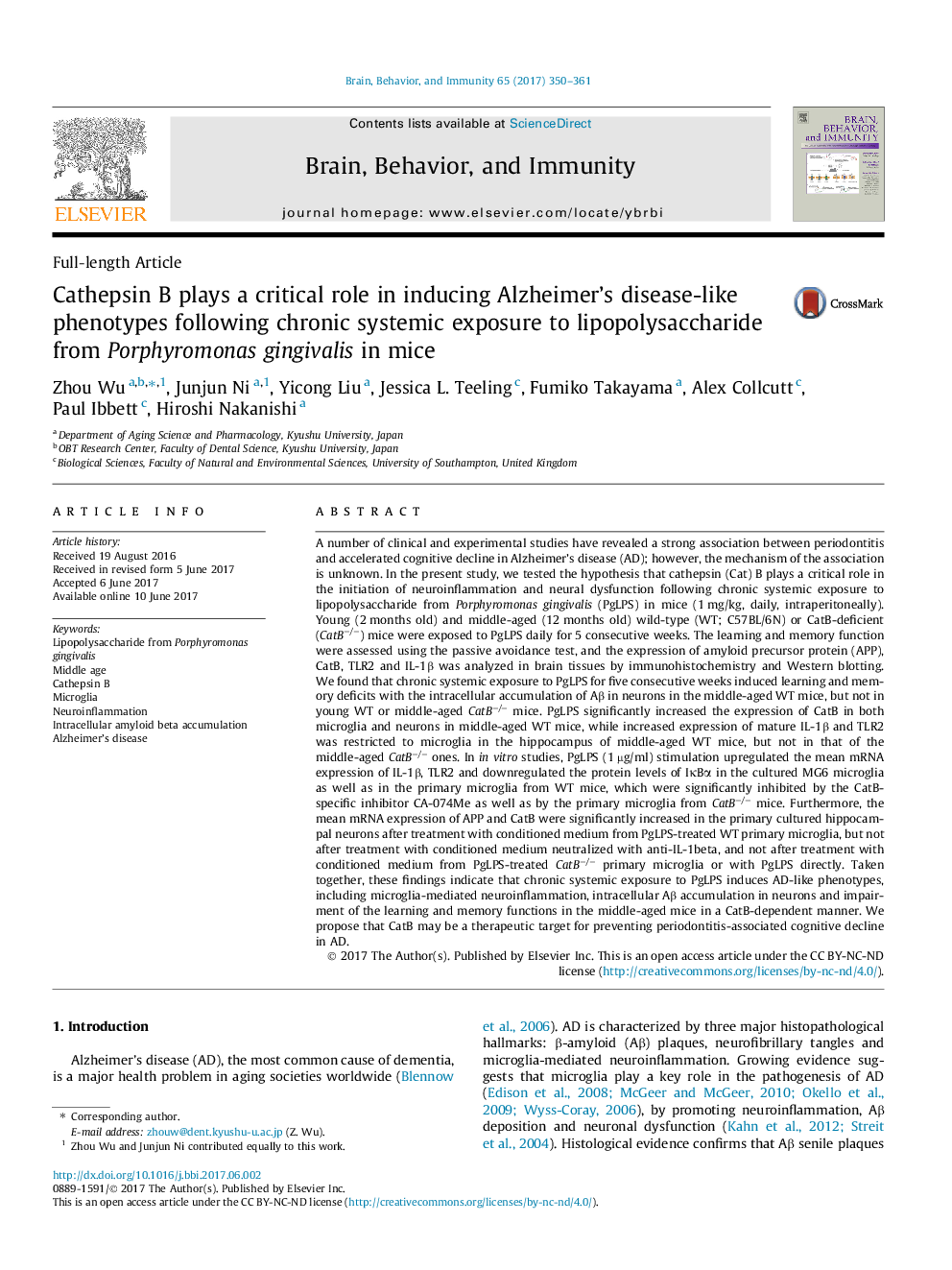| کد مقاله | کد نشریه | سال انتشار | مقاله انگلیسی | نسخه تمام متن |
|---|---|---|---|---|
| 5040608 | 1473902 | 2017 | 12 صفحه PDF | دانلود رایگان |

- Systemic exposure to LPS from Porphyromonas gingivalis induces AD-like phenotypes.
- Cathepsin B is critical for inducing microglia-mediated neuroinflammation.
- Cathepsin B is critical for inducing microglia-dependent Aβ accumulation in neurons.
A number of clinical and experimental studies have revealed a strong association between periodontitis and accelerated cognitive decline in Alzheimer's disease (AD); however, the mechanism of the association is unknown. In the present study, we tested the hypothesis that cathepsin (Cat) B plays a critical role in the initiation of neuroinflammation and neural dysfunction following chronic systemic exposure to lipopolysaccharide from Porphyromonas gingivalis (PgLPS) in mice (1 mg/kg, daily, intraperitoneally). Young (2 months old) and middle-aged (12 months old) wild-type (WT; C57BL/6N) or CatB-deficient (CatBâ/â) mice were exposed to PgLPS daily for 5 consecutive weeks. The learning and memory function were assessed using the passive avoidance test, and the expression of amyloid precursor protein (APP), CatB, TLR2 and IL-1β was analyzed in brain tissues by immunohistochemistry and Western blotting. We found that chronic systemic exposure to PgLPS for five consecutive weeks induced learning and memory deficits with the intracellular accumulation of Aβ in neurons in the middle-aged WT mice, but not in young WT or middle-aged CatBâ/â mice. PgLPS significantly increased the expression of CatB in both microglia and neurons in middle-aged WT mice, while increased expression of mature IL-1β and TLR2 was restricted to microglia in the hippocampus of middle-aged WT mice, but not in that of the middle-aged CatBâ/â ones. In in vitro studies, PgLPS (1 µg/ml) stimulation upregulated the mean mRNA expression of IL-1β, TLR2 and downregulated the protein levels of IκBα in the cultured MG6 microglia as well as in the primary microglia from WT mice, which were significantly inhibited by the CatB-specific inhibitor CA-074Me as well as by the primary microglia from CatBâ/â mice. Furthermore, the mean mRNA expression of APP and CatB were significantly increased in the primary cultured hippocampal neurons after treatment with conditioned medium from PgLPS-treated WT primary microglia, but not after treatment with conditioned medium neutralized with anti-IL-1beta, and not after treatment with conditioned medium from PgLPS-treated CatBâ/â primary microglia or with PgLPS directly. Taken together, these findings indicate that chronic systemic exposure to PgLPS induces AD-like phenotypes, including microglia-mediated neuroinflammation, intracellular Aβ accumulation in neurons and impairment of the learning and memory functions in the middle-aged mice in a CatB-dependent manner. We propose that CatB may be a therapeutic target for preventing periodontitis-associated cognitive decline in AD.
Journal: Brain, Behavior, and Immunity - Volume 65, October 2017, Pages 350-361